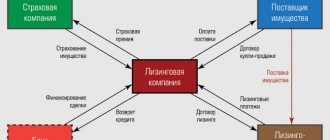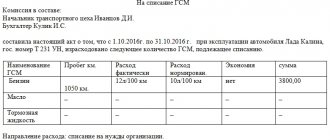Hello! Today we’ll talk about a commercial proposal and how to draw it up. I have been asked similar questions more than once, so the article is “on topic”. Let's start from the very beginning, about what a commercial proposal is, how to draw it up, and at the end I will give examples / samples of a commercial proposal. This article contains recommendations from many experts, so I have no doubt about the reliability of the information.
Content
- What is a commercial offer
- Types of commercial offers
- What functions does a commercial proposal perform?
- Standard commercial proposal structure (template)
- What a good commercial proposal should look like
- Rules for drawing up a commercial proposal
- How to increase the readability of a commercial proposal
- A few more rules (drafting example)
- Mistakes made when drafting
- Checking the commercial offer
- Examples/samples of commercial proposal
- The commercial proposal has been drawn up, what to do next?
Key Features of a Request for Quotation
Sometimes customers and performers “switch places”: the former have to look for the latter
A request for a commercial proposal is drawn up in the form of a letter on behalf of a state (budget) organization or a private company with a request to receive an offer from the addressee company for the sale of goods (provision of services, performance of work) with detailed data on the quality of the goods, prices, features of the services provided, etc. d.
In a response commercial proposal, the customer company, as a rule, receives the following information about:
- types of goods (works, services) sold by the contractor;
- prices for goods (works, services), as well as available personal discounts and special offers;
- preferred payment procedure and the possibility of obtaining a deferment, installment plan, etc.;
- successfully completed transactions in this area of business (which helps to draw a conclusion about the reliability and relevance of the contractor).
Video: how to create an effective commercial proposal
A commercial offer is an advertisement for your business. A request for a commercial proposal (request for a commercial proposal) is the desire of a potential customer to familiarize themselves with this advertisement.
The main purpose of the request is to conclude a profitable deal. This approach to searching for performers guarantees the customer the opportunity to choose the most suitable offer from all the variety available on the market.
There are several types of CP requests. Their classification is based on the legal status of the customer who monitors the proposals. Highlight:
- Private request for a proposal (such a request is not limited by the conditions of preparation and execution).
- State request for CP (the procedure for its implementation is regulated by Federal Law dated 04/05/2013 No. 44-FZ).
Despite the fact that the procedures for sending private and public requests differ significantly, the content of the requests themselves is usually the same and consists of:
- name of the customer company;
- legal and postal addresses, telephone numbers and other contact information of the customer;
- descriptions of the essence of the request (this includes the expected duration of the contract and its cost);
- desired date for the response letter.
- other (additional) conditions (for example, about the language of the CP);
- names of the person responsible for accepting the CP (full name, signature, contact details).
What functions does a commercial proposal perform?
Before you start writing a commercial proposal, you need to understand what functions it performs. In some ways they are similar to the tasks of advertising messages:
- Attract attention.
- Interest.
- Push to buy.
- Create a desire to purchase a product.
Based on these tasks, a commercial proposal is developed. Typically, visuals such as the organization's logo are used at the very beginning.
If a commercial proposal is given to a potential client in printed form, then special attention is paid to the quality of the paper on which the proposal is printed. For greater impact on the client, you can apply special watermarks to the document. Laminated paper will make a pleasant impression on the consumer of the product.
How to submit a commercial proposal (prototype and design)
There are also more complex examples of compreads, which consist of text and graphics. This is for situations when the CP needs to be beautifully designed. In such situations, a prototype is developed first. This is a technical task for the designer. When the design is ready, the design proposal is sent to the potential client. Look at an example of such a prototype commercial proposal for a transport company.
Prototype of a commercial proposal (TOR for the designer).
But a sample control panel is already in design (one of the possible concepts).
Sample commercial proposal in design.
Standard commercial proposal structure (template)
- A title containing a graphic image (usually a logo).
- A subheading that identifies the product/service.
- Attracting attention, advertising services and products.
- All the benefits of cooperation.
- Sender's contact details, trademarks.
When drawing up a commercial proposal, you need to understand that each structural element performs its own separate functions. For example, the title is used to attract attention and motivate further study of the document. This part of the commercial proposal can be called the most important. The subtitle should interest the client even more, and the main text should justify the information that was written above. But at the end of the sentence, as a rule, you need to confirm the consumer’s need for a purchase.
Rules for drawing up a commercial proposal
Before you start writing a proposal, you need to determine who the target audience of this document will be. Then the desires and capabilities of potential clients are determined. It is very important at this stage to find out the real needs of the buyer.
Once the necessary information has been received, you need to structure it. For this purpose, a rough proposal plan is drawn up, indicating the advantages of the companies and various promotions being carried out. The contents of this document may consist of the following sections:
- Clear definition of the problem.
- Options for its resolution.
- Arguments that prove the need to use the services of your organization.
- Description of various promotions and offers that increase the buyer's benefits.
- Call to action.
The title should mention the solution to a specific consumer problem. It is important to show him the final product, which your company’s products will help make.
You should not include information about the company’s achievements in your commercial proposal. It is necessary to avoid long stories about how it all began. A potential consumer is unlikely to be interested in this.
When writing a proposal, you should avoid technical aspects and do not use scientific terms. Information must be conveyed in a language that is simple and understandable to the buyer.
It is worth using clear and understandable arguments that will really help the client confirm his decision to buy the product.
You should not make your commercial offer too extensive. It should be short, crisp and clear. It is unlikely that a potential client will want to read multi-page documents; such an abundance of information may simply scare him away.
It is very important that the proposal is presented in a high-quality manner. It is worth using the services of a professional designer. Beautiful design can attract the attention of consumers.
As an argument you can use:
- Reviews from other clients. This evidence can be called perhaps the most valuable. Especially if this client is quite famous and authoritative. It is very important that the buyer’s response has the same meaning as the commercial offer itself. That is, it is important that these two texts give the reader an understanding that the company is truly effective in a particular area.
- Tell us about your success story. You definitely need to put your own company or yourself at the center of the story. This should be a selling story that will really interest the buyer and encourage him to take some kind of active action.
It is worth understanding that a commercial proposal must be selling, and its author acts as a seller. It is very important to put yourself in the seller’s shoes in order to understand as accurately as possible what the buyer expects from the product or service. You need to use the right reasoning and build communication with the client. This is the only way a commercial proposal will truly produce a positive result.
How to write a commercial proposal (algorithm)
To correctly draw up a commercial proposal, you need:
- Step 1: Use the sample from the link above as a basis.
- Step 2: Replace the logo, call and contacts with your own.
- Step 3: Design a header using the 4U formula.
- Step 4: Describe the client's real "pain" in the first paragraph.
- Step 5: Create an offer with a solution to the “pain”.
- Step 6: Make a graphic divider.
- Step 7: Describe the additional benefits of your proposal.
- Step 8: Address key objections or briefly introduce yourself.
- Step 9: Make a call to action, write a PS with a deadline.
How to increase the readability of a commercial proposal
You can increase the readability of your commercial proposal in the following ways:
- Break the information into paragraphs, do not make them canvases.
- Using subheadings.
- Use of various graphic elements, including illustrations and bulleted lists.
- Using a serif font in print.
- Using different text styles (using italics, bold or underlining to highlight the necessary information).
A few more rules (drafting example)
Title. It is this part of the commercial proposal that is most interesting to the consumer; if it interests him, then the potential client is more likely to read all the information to the end. It is worth assessing how the words “new” and “free” will affect the buyer. In some cases, they can alienate the client.
You should not use a large number of negatives or generalized information. The text font must be the same. It has been proven that almost a third of readers pay attention to quotes and information enclosed in quotation marks. The title should not be succinct or informative.
Main text. In this part of the sales proposal, it is very important that the reader does not lose interest. It is best to fit the information into one small paragraph. And then pay attention to specific details. It is worth highlighting the advantages of the product, and be sure to address the reader as “you.” Writing long and complex sentences can be intimidating. It is not advisable to use professional terms.
It is worth talking about the product in the present tense, indicating its price. It is necessary to provide the client with arguments - the results of surveys, research, and perhaps include one of the consumer reviews. It is undesirable to use superlatives and comparisons. Specificity and clarity are the main conditions for drawing up a good commercial proposal.
Common mistakes when drawing up a USP
There are several mistakes that can kill any original sales proposal. You cannot use false or incorrect information. If an iPhone is offered as a bonus, then it should be given as a gift. You should stay away from boring clichés, for example:
- the lowest prices;
- specialists with practical experience and Internet marketers;
- cheaper than competitors.
Clichés can be eliminated if you add specifics and details about this product.
The USP often has the wrong emphasis. Example: “There are foods that every dog will like.” If a pet store is advertised, then nothing is said about it, there is an erroneous positioning. Often the USP contains unnecessary words that distract attention:
- This;
- let's say;
- For example;
- Maybe.
Mistakes made when drafting
Unnatural praise of the client.
There is no need to use templates and stock phrases that will only alienate a potential client.
Using critical remarks towards the addressee.
There is absolutely no need to do this, even if the company’s goal is to help a potential consumer. This can cause extremely negative emotions in the client. It is best to use carrots and sticks - first highlight the advantages, and only then point out very minor shortcomings.
Oversaturation of the offer with general information about the client.
There is no need to tell the consumer what he already knows. It is better to share completely new and interesting data that the buyer will be interested in studying.
Intimidation of the client or so-called “horror stories”.
Under no circumstances should you scare the consumer or tell him that without your help something terrible could happen. No negativity or stereotypes. It is worth highlighting the advantages of using the product, casually comparing it with what we have now (use the words: more convenient, more profitable, more effective), giving only specific information.
Sending one proposal to a large number of people at once.
Non-personalized information will cause less interest among potential buyers. The return on such offers will be minimal. There is no need to try to reach a large audience at once. It is better to highlight the sector that is most likely to produce excellent results. It is important to write a business proposal in such a way that the reader can feel that he is being spoken to in private. It is possible to use additional information that will indicate that communication is being conducted specifically with this client. It is worth using information about previous communication, if of course there was one.
Misunderstanding of the concept of a “long” letter.
Many are sure that the client is not interested in large amounts of information. However, you should understand that the reader will consider any boring and completely uninteresting letter to be long. The size of a catchy and truly interesting commercial offer will not scare the consumer, because he will read all the available information in one go.
It’s not for nothing that people can often call very short films boring and drawn out, and call a 3-hour movie the most exciting, without mentioning its duration. The same is true with works of art, news, books, letters. The reader will not perceive 5 sheets of commercial proposal negatively if they are truly informative and catchy.
The first priority is to put the sentence in compliance with grammatical rules.
This attitude towards writing texts can develop from school, where the main factor was the grammatical component. In life, everything is completely different. It is much more important for the reader to understand what is written about. It is necessary that the information is read and perceived by the client easily and informally. It is worth constructing the offer so that it resembles a real communication between the seller and the buyer. Here it will be quite acceptable to use fragments of sentences and phrases, sometimes even desirable.
Give the client a reason not to look into your business proposal.
You should not naively assume that the reader will be extremely interested in information about your company, especially about its history. It's not like that at all. This is the least interesting to a potential buyer. It is necessary to attract his attention with some kind of provocation, an unusual statement - in a word, everything that will bring him out of balance and force him to read the commercial proposal to the end. It is worth considering the fact that maintaining interest is an equally important aspect. You need to focus on what can motivate a person. Most often, needs appear due to some fear, a desire to become individual, a feeling of guilt, a desire to become beautiful or healthy. It is in this vein that it is worth considering the problem and devoting a commercial proposal to it. And then show that the proposed product can satisfy all needs.
Unsubstantiated statements.
It is unlikely that the client will be receptive to your commercial offer. It is imperative to back up the information with very specific evidence. It is worth bringing the clearest arguments. This approach can convince the reader to buy the product or cooperate.
Checking the commercial offer
There are several fairly simple ways to help you understand what impact an offer will have on the recipient.
- The so-called “quick scan” check. To do this, you just need to look at the document. It is important to understand which parts of the text stand out in such a way that you actually want to read them. These are headings, logos, text highlights, photographs. If the information used there could help create a holistic picture of the essence of the commercial proposal, then everything was done correctly.
- Check for understanding. It is important to find among your friends and acquaintances a person who would fit the target audience of your proposal. If, after the first reading, he grasped all the main ideas of the document and saw the advantages of the presented product, then we can conclude that the proposal was drawn up correctly.
- Finger check. It’s worth trying to read the text without words about the product like “best”, “unique”. If the sentence is interesting to read and in this form, then everything was done correctly. It is very important that all laudatory speeches about your company are supported by accurate data, reviews, stories, and certificates.
The commercial proposal has been drawn up, what to do next?
You should not naively believe that after drawing up a commercial proposal, the work ends. You will need to not only send it to the recipients, but also actively monitor how they responded to your letter. It is very important to stay informed. It is worth distinguishing between several stages of passing a proposal: “studying”, “considering alternative options”, “your proposal has been selected”. Knowing what is happening with your document in a potential client’s company is simply necessary to control your own sales, as well as opportunities for sales growth and promotion.
It is worth compiling some kind of customer database, checking the accuracy of the contact information found, for this you can call the specified number and check the email address. Before sending or immediately afterwards, it is worth informing the secretary or manager about sending a commercial proposal. There is no need to communicate using slang or informal communication. It is worth specifying the time during which the answer will be given.
It is imperative to indicate the exact details of the addressee - full name, company name, position. Firstly, this will make the commercial offer personalized, and secondly, the system will not consider the letter as spam.
What to write in a commercial proposal
What needs to be written in a commercial proposal, or rather in its content, in order not only to arouse genuine interest in the user, but also to convince him that the advertised product or service is something that he cannot do without and at the moment it really needed. Of course, only an experienced marketer who knows his business can create such a symbiosis of beautiful text and pictures that harmoniously combine with each other.
The question immediately arises: “What should be in the commercial proposal?” To say that there is no ideal layout for advertising material that actually sells is an understatement. There are certain requirements, following which you can produce your own unique advertising material that the public will like. It includes:
- The presence of advertising text - the material should not describe the organization or talk about the product or service offered, on the contrary, an extremely short paragraph with “catchy” content;
- Picture - the image should not be of poor quality, it also cannot contain illegal elements, any eroticism or calls for negative actions;
- Link – a link to the site, or immediately to the product that is offered in this context, must meet the user’s expectations, or the percentage of refusals and negative reviews will increase;
- Design design. If the offer has a beautiful and “tasty” appearance, the chance that it will interest a potential client will increase significantly. Beautiful design, impressive photos/pictures or diagrams will clearly show the user all the positive characteristics of your offer, and will set him up to buy your company’s products.
It is perhaps worth mentioning the hotel categories into which the commercial offer is divided, and depending on its type, the principle of writing is based. Experts have identified 2 main types of commercial offers:
- Personified (“cold”). Such proposals are made for an unprepared (random) recipient. As is correct, users see spam in such messages and do not take them seriously, and sometimes even with irritation. But, nevertheless, experienced entrepreneurs use this type, since after all, someone from the client base may be interested in it.
- Not personalized, that is, “hot”. The text for this type is developed for a specific recipient, and accordingly, the volume of what is written and its content will differ radically. The purpose of such offers is to tell an already regular customer base about new products.
Based on all of the above, a clear picture is already emerging of what the commercial offer includes. At first glance, this is a simple material, as many people think, containing only 2-3 lines of text, a picture and a link, but think about how you need to compose it so that a person, without even specifying the price for a month of promotion in Yandex, is already in a hurry to switch to website, contact managers and order it.










